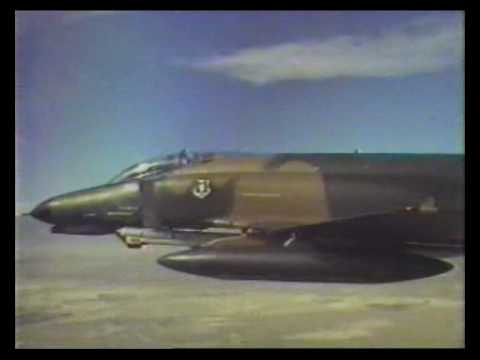F-4G/F-16C Wild Weasels
Wild Weasel is a nickname for aircraft of the United States Air Force tasked with the Suppression of Enemy Air Defenses (SEAD) mission. Initially known by the operational code “IRON HAND” when first authorized on August 12, 1965, the term “Wild Weasel” derives from Project Wild Weasel, the USAF development program for a dedicated SAM-detection and suppression aircraft. Originally named “Project Ferret”, denoting a predatory animal that goes into its prey’s den to kill it (hence: “to ferret out”), the name was changed to differentiate it from the code-name “Ferret” that had been used during World War II for radar counter-measures bombers.
The F-4E, the most advanced Phantom variant with extensive ground-attack capabilities and an internal gun became the basis for the F-4G Wild Weasel V (also known as the Advanced Wild Weasel). This modification consisted of removing the gun and replacing it with the APR-38(t) Radar Homing and Warning Receiver (later upgraded to the APR-47), and a cockpit upgrade for the back seat to manage the electronic combat environment. A total of 116 F-4G models were converted from F-4Es with the first one flying in 1975. Squadron service began in 1978.
F-4Gs were deployed to four active wings. Two were stationed at George AFB, Victorville, CA. as part of the rapid deployment force; one wing was assigned to USAFE (US Air Forces Europe) at Spangdahlem AB, Germany; and the other to PACAF (Pacific Air Forces) at Clark AFB, Philippines. F-4G’s from George AFB And Spangdalhem AB saw combat during the 1991 Gulf War successfully protecting strike packages from enemy air defenses. During this conflict the F-4G saw heavy use, with only a single loss. An aircraft from Spangdahlem AB crashed in Saudi Arabia while returning from a mission. After an investigation into the loss of the aircraft which occurred during several aborted landing attempts in a sandstorm, it was determined that a fuel cell was punctured by anti-aircraft fire. The pilot and EWO safely ejected after the engines seized when the aircraft ran out of fuel attempting to land at a forward airstrip.
After the Gulf War the George AFB aircraft were assigned to the 124th Wing of the Air National Guard at Boise, ID, 190th Fighter Squadron. Aircraft from Spangdahlem and Clark were assigned to the 57th Fighter Wing (Active AF) assigned to Nellis AFB at Las Vegas, NV, 561st Fighter Squadron. The aircraft remained in service until 1996, with both squadrons participating in frequent deployments to Saudi Arabia and Turkey in support of Operation Provide Comfort, Operation Southern Watch, and Operation Vigiliant Warrior enforcing the no-fly zones over Iraq. By this time the F-4G was the last operational variant of the Phantom II in the US forces. Many of the airframes were later used as target drones and Aircraft Battle Damage Repair training aids.

